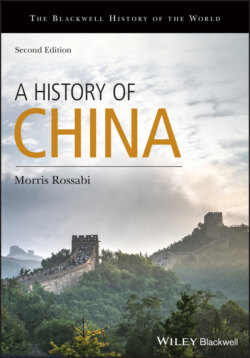Читать книгу A History of China - Morris Rossabi - Страница 20
THE SHANG AND THE ORIGINS OF CHINESE CIVILIZATION
ОглавлениеThe Shang is not only the first attested dynasty of China but also the first era to provide an array of rich source materials. More abundant information translates into more precise reconstruction of its history than at any previous time in China’s history. Excavations in the last Shang capital of Anyang have uncovered artifacts, such as bronzes, pottery, jades, and oracle bones, offering vivid glimpses of society. The names of about thirty kings have been identified in the oracle-bone inscriptions, and archeologists have located the sites of eight different capitals of the dynasty. Later written accounts yield stereotypical portraits of the kings, providing insights into the later dynasties but primarily offering anecdotes with a specific moral message about the Shang. For example, these sources depict Cheng Tang, the first ruler, as a great unifier who represented, in Chinese eyes, the highest moral standards. According to these accounts, many regions voluntarily accepted his rule because they recognized that he embodied the virtues prized in Chinese culture. The same sources depict his adversaries, in particular King Jie, the last ruler of the so-called Xia dynasty, as despicable exploiters and oppressors of their subjects. Victory for Cheng Tang was almost predictable, for, in these later accounts, the moral superiority of the new ruler would naturally attract others to join him in defeating the evil and dissolute tyrant.
The other leading Shang figures are also portrayed in dubious stereotypes that served to support the orthodox political morality. The written sources laud rulers of probity but vilify licentious and corrupt kings in order to justify rebellion and usurpation. Pan Geng, for example, is portrayed as a hero because he reputedly moved the capital city to Yin at a propitious time. On the other hand, King Zhou, the last ruler of the dynasty, is presented as a grotesque monster. According to these later sources, he ignored the government, sponsored outrageous orgies, and exacted higher taxes to pay for the lavishness at court. Critics of his policies and activities took their lives in their hands. He had recalcitrant ministers sliced open so that he could examine their hearts; he used the so-called “grilled roast” technique to incinerate, in a most painful way, any dissenters; and he killed a female bedmate who was apparently not enchanted with his sexual proclivities. This horrifying portrait of a brutal tyrant naturally served to justify the Zhou dynasty’s overthrow of the Shang in the eleventh century BCE. The political motives underlying this depiction arouse suspicions about its accuracy. Nor can the Shang’s fall be attributed to a depraved and blood-thirsty monster. Economic, social, and political factors, some of which will never be known because of the limitations of the written sources and the material artifacts, contributed much more to its decline than the alleged brutality of a loathsome, almost inhuman king.
Despite these lacunae, archeological data and written inscriptions reveal considerable development in almost every area of endeavor. The Shang, the dates of which are still in dispute, though it certainly ended in 1028 BCE, witnessed remarkable changes from Neolithic cultures. Cities rather than towns were built. Rituals and ceremonies were more elaborate, and a recognizable system of writing was created. The populations of the cities were larger, necessitating a more complicated social system. Nearly every site and institution was on a larger scale than in the Neolithic.
The modern city of Anyang (in modern Henan province), in which the Shang capital of Yin was located, has turned out to be a treasure house of Shang civilization. The site stretches beyond the old city walls of Anyang to include small villages and tomb complexes. The village of Xiaotun, the principal site thus far excavated, consisted of rectangular houses with stamped-earth bases, large tombs adjacent to smaller burial pits, and ritual areas also with burial pits. The excavations indicate that Xiaotun was inhabited prior to the shifting of the capital. Even in this early period, the several hundred or so residences uncovered had drainage ditches, and graves of seemingly important individuals contained bronze ritual vessels, as well as the remains of human sacrifices.
With the establishment of the capital near Xiaotun, the buildings assumed larger proportions – evidence of a more sophisticated society. The inhabitants erected several large above-ground structures, some with thirty layers of stamped earth, which have been identified as palaces and temples. The sizable quantity of below-ground pit dwellings, which contained animal bones, pottery, and tools, attest to the large number of ordinary residents who farmed the fields or acted as service personnel for the palace inhabitants. Enormous underground storage pits, which preserved the goods of the royal family and the elite, and numerous bronze, jade, and stone workshops were built near the palaces. Also adjacent were colossal tombs, with human and dog sacrifices; sixteen people (men, women, and children) were sacrificed in one such tomb. Precious objects overflowed within the pit, the coffin, and other parts of the grave. Hundreds of jades, bronzes, and pottery vessels, among other goods, were scattered throughout the tombs. Other objects placed in the tombs included weapons, musical instruments, and cowry shells (which were used as money).
